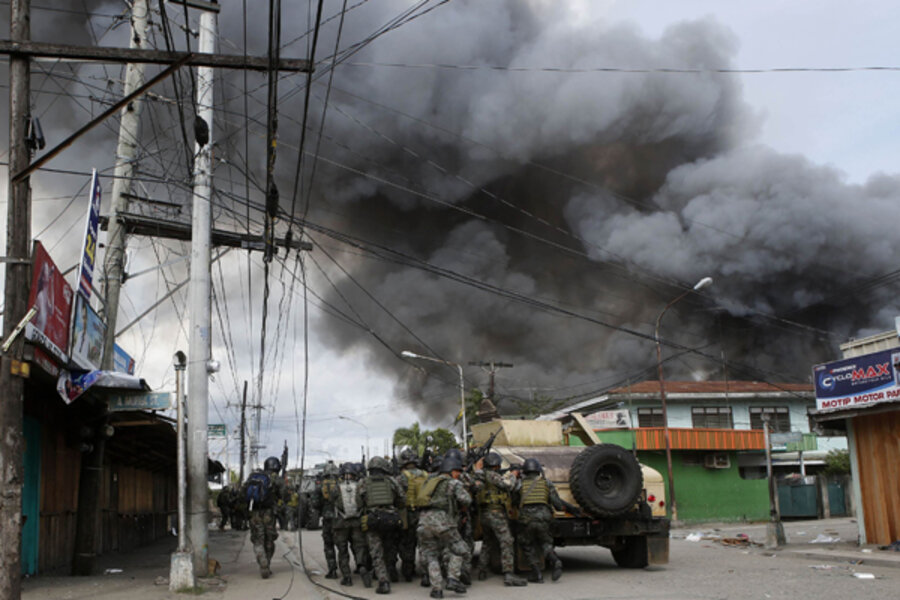Separatist clashes in Philippines could renew insurgency
Loading...
• A daily summary of global reports on security issues.
Fighting between Muslim separatists and government troops spread to a second island in the southern Philippines today, while a hostage standoff entered its fourth day, raising fears that an insurgent threat is on the rise there.
Flames engulfed homes and periodic gunfire echoed across Zamboanga city on the island of Mindanao, where a breakaway faction of the Moro National Liberation Front (MNLF) has held some 170 hostages since Monday, according to Reuters and Associated Press.
At least 13,000 people have been evacuated from districts across Zamboanga, government sources told CNN.
"We don't want any civilian casualties," Army spokesman Domingo Tutaan said at a news conference. "[We] want that this incident in Zamboanga to be resolved immediately or as soon as possible."
The conflict began on Monday after the MNLF tried to raise a flag in Zamboanga’s city hall, declaring independence from the national government, police told The New York Times. Rebels say it was a peaceful march, but Steven Rood from the Asia Foundation said he’s skeptical.
“Judging by the personnel in those boats, it is utterly unthinkable that this was meant as a peaceful rally,” Mr. Rood told Time magazine.
The separatist MNLF movement was founded in 1971 with the aim of creating an independent Muslim state in the predominantly Catholic nation. The group signed a peace deal with the government in 1996, though there have been splinter groups, like the Moro Islamic Liberation Front (MILF), which signed its own peace deal with the government last October. That 2012 deal raised high hopes, reported The Christian Science Monitor. More than 120,000 people have been killed and 2 million displaced over the four decades of conflict.
MNLF-leader Nur Misuari says his group is not behind the events this week, reports CNN, though the government disagrees.
“Nur Misuari is denying his involvement, but all indications point to his running this operation in Zamboanga City from the very beginning,” military spokesman Col. Rodrigo Gregorio told The New York Times.
Reuters reports that "Muslim Moro make up the largest non-Christian group in the Philippines, at around 10 percent of a total 97 million Filipinos.”
Zamboanga city mayor Maria Isabell Climaco said the rebels are calling for the United Nations to come in and broker and end to the fighting.
According to the AP:
The four-day crisis has virtually paralyzed Zamboanga, a lively trading city of nearly a million people, with most flights and ferry services suspended. Communities near the clashes resembled a war zone, with armored troop carriers lining streets, troops massing at a school and snipers taking positions atop buildings. A mosque and its minaret were pockmarked with bullet holes.
Today’s attack on the nearby island of Basilan is believed to be led by a separate group, the Al Qaeda-linked Abu Sayyaf, reports the AP.
Moro rebels joined the Abu Sayyaf in Thursday's attack. [Army Col. Carlito] Galvez said that the Abu Sayyaf, which is a violent faction of the Muslim separatist rebellion, was trying to take advantage of the hostage standoff in Zamboanga “to try to improve its influence and mass base support.”
According to Time, “[p]reviously, the MNLF has been involved in hostage crises from which they have been allowed to walk away. But the current standoff in Zamboanga, with at least four civilian casualties, is the most severe carried out by the group since 1996. ‘There will be demands for accountability,’ says Rood, “but the negotiations will be very tough.’”








